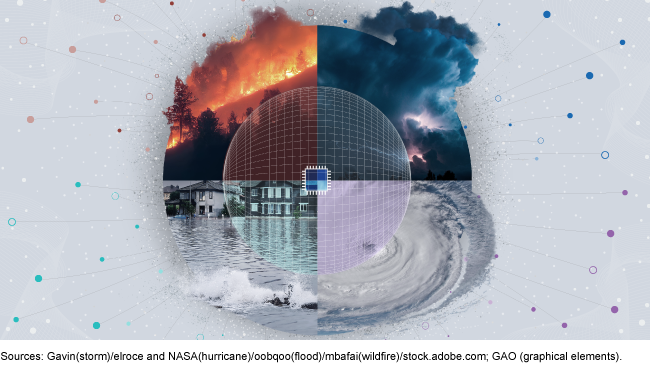Artificial Intelligence in Natural Hazard Modeling: Severe Storms, Hurricanes, Floods, and Wildfires
Fast Facts
Severe storms, hurricanes, floods, and wildfires kill hundreds of people and cause billions of dollars in damage in the U.S. each year. Forecasting models can help predict these hazards. Machine learning—a type of artificial intelligence—can help improve model accuracy, increase warning times, and reduce uncertainty.
Some machine learning forecasting models are in use, but there are challenges to developing and adopting them more widely. For example, there may not be enough data from some rural areas to train machine learning models.
Our policy options—such as improving how data is collected, shared, and used—may help address the challenges.

Highlights
What GAO Found
GAO found that machine learning, a type of artificial intelligence (AI) that uses algorithms to identify patterns in information, is being applied to forecasting models for natural hazards such as severe storms, hurricanes, floods, and wildfires, which can lead to natural disasters. A few machine learning models are used operationally—in routine forecasting—such as one that may improve the warning time for severe storms. Some uses of machine learning are considered close to operational, while others require years of development and testing.
GAO identified potential benefits of applying machine learning to this field, including:
- Reducing the time required to make forecasts by replacing components of models that are slow and that increase the cost of modeling.
- Increasing model accuracy by more fully exploiting available data, using other data that traditional models cannot, and creating synthetic data to fill gaps.
- Reducing the uncertainty of model output by improving ensemble modeling—the processes of generating combined predictions from numerous models—and making better use of historical data.
Forecasting natural disasters using machine learning

GAO also identified challenges to the use of machine learning. For example:
- Data limitations hamper the training of machine learning models and can reduce accuracy in some regions, such as rural areas where weather observations are sparse.
- A lack of trust and understanding of the algorithms as well as concerns about bias can make forecasters and other users hesitant to use machine learning models.
- Limited coordination and collaboration create challenges for fully developing some machine learning models. For example, some forecasters told us they lack opportunities to interact with researchers and convey their needs.
- Workforce and resource gaps also create challenges. For example, the upfront costs to develop and run machine learning models are high, and some companies working on these models do not fully understand the data and phenomena they are modeling, according to academic researchers.
GAO identified five policy options that could help address these challenges. These options are intended to inform policymakers, including Congress, federal and state agencies, academic and research institutions, and industry of potential policy implementations. The status quo option illustrates a scenario in which government policymakers take no additional actions beyond current ongoing efforts.
Policy Options to Help Address Challenges to the Use of Machine Learning in Natural Hazard Modeling
| Policy Option | Opportunities | Considerations |
|---|---|---|
| Facilitate improved data collection, sharing, and use (report p. 37). Government policymakers could expand use of existing observational data and infrastructure to close gaps, expand access to certain data, and (in conjunction with other policymakers) establish guidelines for making data AI-ready. |
|
|
| Expand education and training (report p. 38). Government policymakers could update education requirements to include machine learning-related coursework and expand learning and support centers, while academic policymakers could adjust physical science curricula to include more machine learning coursework. |
|
|
| Address hiring and retention barriers and certain resource shortfalls (report p. 39). Government policymakers could address pay scale limitations for positions that include machine learning expertise and work with private sector policymakers to expand the use of public-private partnerships (PPP). |
|
|
| Take steps to mitigate bias and foster trust in data and machine learning models (report p. 40). Policymakers could establish efforts to better understand and mitigate various forms of bias, support inclusion of diverse stakeholders for machine learning models, and develop guidelines or best practices for reporting methodological choices. |
|
|
| Maintain status quo efforts (report p. 41). Government policymakers could maintain existing policy efforts and organizational structures, along with existing strategic plans and agency commitments. |
|
|
Source: GAO. | GAO-24-106213
Why GAO Did This Study
Natural disasters cause on average hundreds of deaths and billions of dollars in damage in the U.S. each year. Forecasting natural disasters relies on computer modeling and is important for preparedness and response, which can in turn save lives and protect property. AI is a powerful tool that can automate processes, rapidly analyze massive data sets, enable modelers to gain new insights, and boost efficiency.
This report on the use of machine learning in natural hazard modeling discusses (1) the emerging and current use of machine learning for modeling severe storms, hurricanes, floods, and wildfires, and the potential benefits of this use; (2) challenges surrounding the use of machine learning; and (3) policy options to address challenges or enhance benefits of the use of machine learning.
GAO reviewed the use of machine learning to model severe storms, hurricanes, floods, and wildfires across development and operational stages; interviewed a range of stakeholder groups, including government, industry, academia, and professional organizations; convened a meeting of experts in conjunction with the National Academies; and reviewed key reports and scientific literature. GAO is identifying policy options in this report.
For more information, contact Brian Bothwell at (202) 512-6888 or bothwellb@gao.gov.
